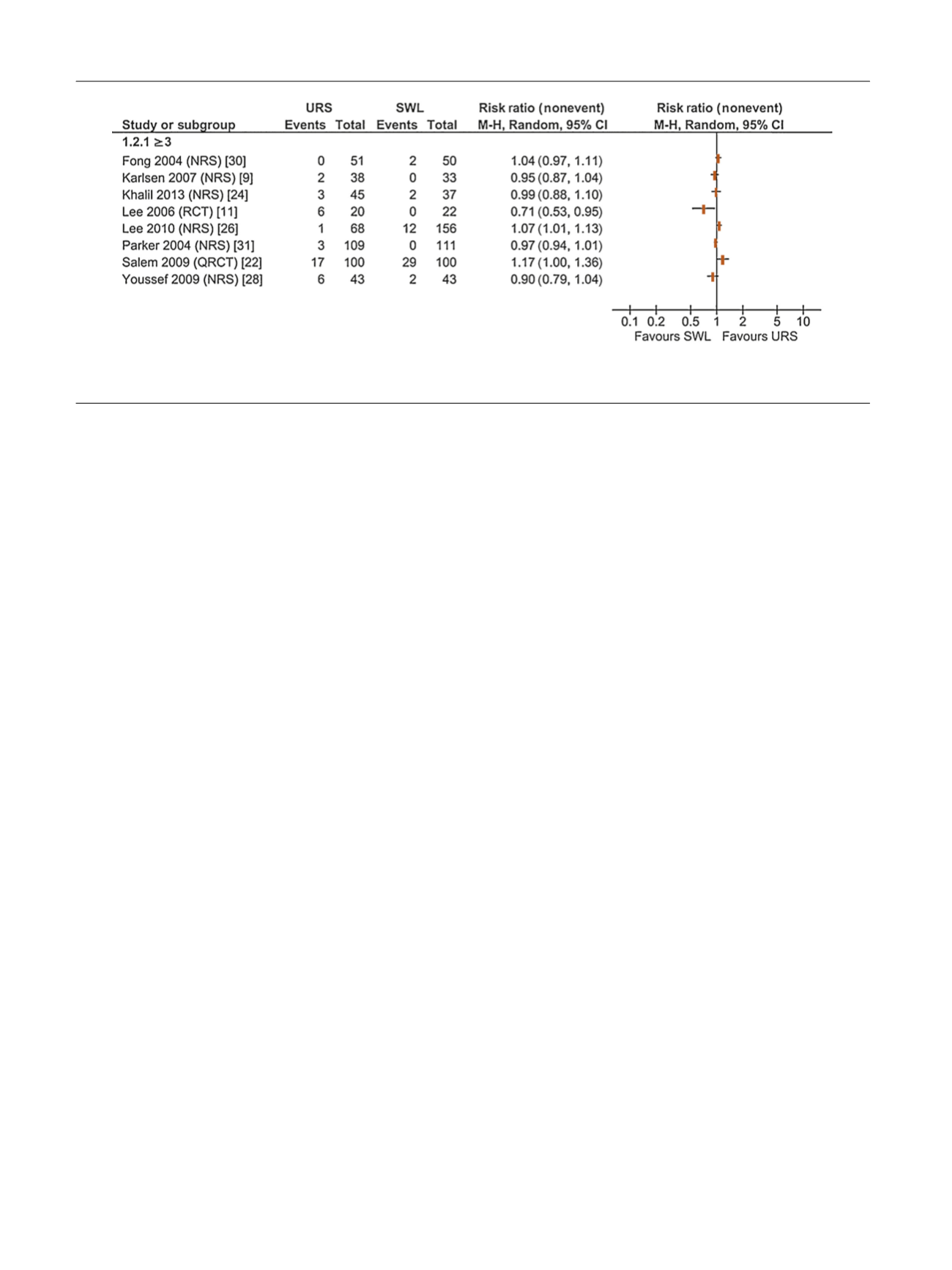

high as 30% in one study
[11] .In other studies, reported
ureteric injury rates after URS were much lower at 0–6.6%
[9,23,25,26,29,32].
Haematuria post-treatment was reported on by four
studies; one RCT
[11], one QRCT
[22], and two NRSs
[9,23]. Two studies reported associated
p
values; in one
study
[9]haematuria rates (assessed according to a visual
analogue score) were significantly higher after URS than
SWL. In the other study
[23], rates of gross haematuria
following treatment were significantly higher after SWL
than URS, occurring in 20% of patients after SWL, compared
with 2.5% of patients treated with URS.
The rate of steinstrasse following treatment with SWL
was reported on by two studies
[26,28]ranging between
2.3% and 7.7%.
Post-treatment voiding symptoms were assessed by one
study
[23]and were significantly more common after
treatment with URS (33.7%) compared with SWL (6.2%;
p
<
0.05).
Reported rates of pain were assessed by five studies
[9,11,23,26,31] .Different methods and time points were
used to assess the pain. In general, the reported pain levels
were relatively low. Two studies reported significantly
higher rates of pain after URS
[11,23], while the three
remaining studies showed no significant difference in pain
after SWL or URS treatment
[9,26,31] .3.7.
Retreatment rate
Retreatment was defined as a subsequent intervention for
the stone disease using the same therapeutic technique as
the initial treatment. A total of 11 studies reported on
retreatment rates; three RCTs
[11,20,35] ,one QRCT
[22] ,and seven NRSs
[5,9,23,30,33,34,38] .Reported retreat-
ment rates were higher for SWL compared with URS in all
studies but one
[9]. Reported rates ranged from 3–61.1%
for SWL compared with 0–18% for URS. Altogether,
p
-
values were only reported in three out of the 11 studies
[5,35,38]of which two were statistically significant
(
p
0.001)
[35,38].
3.8.
Need for secondary procedures
Secondary procedures were defined as any procedure
performed to clear the stone, beyond the primary proce-
dure, including retreatment using the same modality. A
total of 11 studies comparing SWL with URS reported on the
need for secondary procedures; three RCTs
[11,20,35] ,one
QRCT
[22], and eight NRSs
[5,26,28,30–32,38]. Overall,
between these 11 studies, 880 patients were treated
primarily with SWL and 787 patients were treated primarily
with URS. The need for secondary procedures ranged from
2.6% to 45% in the primary SWL group and 4–50% in the
primary URS group. For patients treated primarily with SWL
and URS, respectively, the secondary procedure modalities
(eg, SWL, URS, antegrade URS, and ureterolithotomy) varied
greatly between studies. In two studies
[28,38]the need for
secondary procedures was equivalent between the two
treatment modalities. In three studies
[5,11,26]the need for
secondary procedures was greater for URS than for SWL,
although only one of these
[5]provided a
p
-value which was
not statistically significant. In the remaining six studies, the
need for secondary procedures was greater for SWL than
URS, although again, where given,
p
-values never reached
statistical significance.
3.9.
Need for adjunctive procedures
Adjunctive procedures were defined as procedures needed
to deal with a postoperative complication of the primary
treatment or temporary procedures necessary to perform
the primary treatment (eg, JJ stent or nephrostomy
placement). A total of seven studies reported on the need
for adjunctive procedures; one RCT
[11], one QRCT
[22], and
five NRSs
[27–29,31,32] .In the majority of cases, this
adjunctive procedure was the insertion of a JJ stent and was
a more common occurrence when primary treatment was
URS rather than SWL. Furthermore, in six of the seven
studies
[11,22,27–29,32], an adjunctive procedure (inser-
tion of a JJ stent) was only required in patients who had
undergone URS rather than SWL. Conversely, in one study
[(Fig._2)TD$FIG]
Fig. 2 – Forest plot (Clavien-Dindo Grade
I
3 reported complications in intergroup studies).CI = confidence interval; NRS = nonrandomised studies;
QRCT = quasi-randomised controlled trial; RCT = randomised controlled trial; SWL = shock wave lithotripsy; URS = ureteroscopy.
E U R O P E A N U R O L O G Y 7 2 ( 2 0 1 7 ) 7 7 2 – 7 8 6
780
















